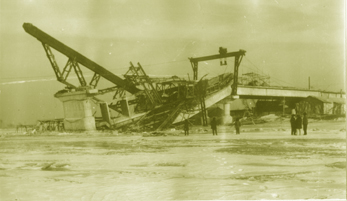
Geotimes Home | AGI Home | Information Services | Geoscience Education | Public Policy | Programs | Publications | Careers

 Confirming
a Chinese earthquake prediction
Confirming
a Chinese earthquake prediction
For nearly three decades after Chinese officials predicted the powerful earthquake
that hit Haicheng in the north of China on Feb. 4, 1975, details of their prediction
process remained closely guarded. But now, after gaining access to formerly
classified documents and key people involved with the process, a team of scientists
has reconstructed this important event and concluded that earthquake prediction,
though challenging, is not impossible, at least for some earthquakes.
The Feb. 4, 1975, magnitude-7.3
Haicheng quake damaged more than 2,000 bridges, such as this one, as well as
homes, transport pipelines, hydraulic facilities. The photo is courtesy of Kelin
Wang, published in Liaoning Province Earthquake Administration (2005), Retrospective
Photos of the Successful Prediction of the 1975 Ms 7.3 Haicheng Earthquake,
Seismological Press, Beijing.
More than 2,000 people were killed when the magnitude-7.3 quake struck, but
Chinese officials said that their prediction and subsequent evacuation orders
just hours before the shakeup saved the lives of thousands more. Although the
accomplishment attracted worldwide interest, it occurred during a period of
political turmoil — China's Cultural Revolution — and most details
of the prediction and evacuation were kept secret as leaders attempted to control
perceptions of their success and political authority. This paucity of information,
along with the failure of Chinese officials to predict a devastating magnitude-7.8
earthquake in Tangshan about a year later, which killed more than 240,000 people,
led experts to question the reality of the prediction claim over the years.
In this month's issue of the Bulletin of the Seismological Society of America,
however, Kelin Wang, a senior research scientist at the Geological Survey of
Canada in British Columbia, and colleagues say the prediction was legitimate.
The Haicheng earthquake is the "first, and so far only, case where a large
earthquake was predicted," says Susan Hough, a seismologist with the U.S.
Geological Survey in Pasadena, Calif.
Wang's team reviewed relevant documents and interviewed key witnesses in the
prediction process to compile a detailed account of the events and decisions
that led to the Haicheng prediction and evacuation. The team wrote that the
prediction was "a blend of confusion, empirical analysis, intuitive judgment,
and good luck." After a series of large earthquakes hit northern China
in the late 1960s, the report explains, Chinese authorities ramped up monitoring,
prediction and public education efforts. By June 1974, based on precursory anomalies
that included a shift in land levels in the nearby Bohai Sea area, officials
issued the first of two "middle-term" predictions that warned of an
earthquake within one to two years.
No official "short-term" predictions — warning of an earthquake
within a few months — were made, the team says, but some Chinese officials
made "imminent" predictions, based on an increase in foreshock activity
in the 24 hours before the main shock. Although the imminent predictions correctly
identified the quake's location, they did not specify a time, and they underestimated
the quake's magnitude. Nonetheless, the predictions — along with some actions
taken spontaneously by local citizens — triggered warnings and evacuation
orders around the area where the earthquake eventually occurred. According to
the team, the evacuations, along with the durable style of housing construction
in the area and the time of the main shock — 7:36 p.m., when most people
were neither at work nor sleeping — saved thousands of lives.
Qi-Fu Chen, a research professor with the China Earthquake Administration in
Beijing and co-author of the report, calls the Haicheng experience a "useful
reference" for reducing earthquake disasters through prediction and preparedness.
"The Haicheng earthquake provides hope to precursor-based earthquake prediction,"
Chen says. It shows that "precursor-based earthquake prediction is not
impossible," he says, but it is nonetheless a challenging task that "will
require many years of research."
Part of that challenge is the simple fact that "fundamentally, we don't
know why an earthquake starts," Hough says, and so "in a way, we don't
know what we're looking for." In addition, precursor events can vary from
one earthquake to the next. While the Haicheng earthquake was preceded by foreshocks,
for instance, the later Tangshan earthquake was not. Because "some large
earthquakes strike without this sort of harbinger," Hough says, referring
to the foreshocks, "clearly one can't look to Haicheng as a prototype for
earthquake prediction."
Currently, Hough says, "there isn't even a road map" as to what is
needed in order to make reliable earthquake predictions (See Geotimes,
March 2005). If a breakthrough in prediction does come, she says, "it will
probably be some breakthrough that comes out of left field," from a place
where scientists don't even know to look.
Regardless of the significance of the Haicheng earthquake prediction in the
long run, the event was valuable in that it "showed the importance of public
education," Chen says. According to the paper's authors, efforts to educate
the public prior to the earthquake included the distribution of brochures, which
explained earthquake concepts and described how to make amateur observations
of precursory events that could help officials in formulating their predictions.
Jennifer Yauck
Links:
"Earthquakes: Predicting the
Unpredictable?," Geotimes, March 2005
"Earthquake Prediction and the Developing
World," Geotimes, March 2004
 |
Geotimes Home | AGI Home | Information Services | Geoscience Education | Public Policy | Programs | Publications | Careers |